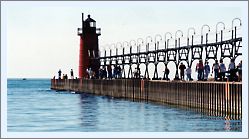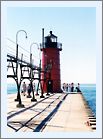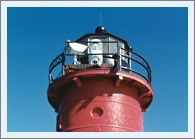|
Historical Information

While a few white settlers were already homesteading in the area
in 1831, it was not until lumbermen began to tap the bounty of the areas
forests in the 1850's that a viable settlement began to appear at the
mouth of the Black River. With the river serving as the primary conduit
for the movement of logs from the forest to the sawmills at the mouth of
the river, a growing number of vessels were entering the river to
transport the products of the mills to the lumber-hungry cities growing
around the great lakes.
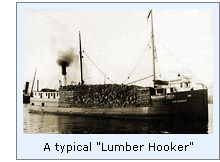 The first major attempt at harbor
improvements was undertaken by a group of local merchants in 1861 with
the construction of two cribwork protecting piers protruding into the
lake from the north and south shores of the river mouth. The protected
channel between the piers was dredged to a depth of between six and
seven feet, opening the river to all but the largest lumber hookers of
the day. The first major attempt at harbor
improvements was undertaken by a group of local merchants in 1861 with
the construction of two cribwork protecting piers protruding into the
lake from the north and south shores of the river mouth. The protected
channel between the piers was dredged to a depth of between six and
seven feet, opening the river to all but the largest lumber hookers of
the day.
With the construction of his large
sawmill in 1866, George Hannas became the village's premier employer and
developer, and soon the inevitable string of stores, hotels, bars and
churches appeared to nourish the hearts and souls of the areas growing
community.
As South Haven grew in prominence as
a shipping port, the Army Corps of Engineers assumed responsibility for
harbor improvements in 1867, and over the following year increased the
width of the channel to 120 feet, and extended the piers far enough to
maintain an average channel depth of twelve feet.
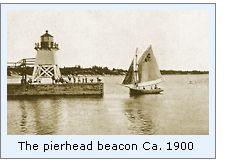 As work on the harbor improvements came
to a close in the summer of 1868, the Lighthouse Board requested an
appropriation of $6,000 for the construction of a pierhead beacon, and
keepers dwelling. A site on the nearby bluff was selected for the
dwelling the following year, and plans were made to begin construction
of the station early in 1870. Short of funds, in a sweeping measure of
July 12th of that year, Congress recalled all unexpended funds from
Federal agencies, and without funding, the work at South Haven was
forced to be put on hold until a new appropriation could be made. As work on the harbor improvements came
to a close in the summer of 1868, the Lighthouse Board requested an
appropriation of $6,000 for the construction of a pierhead beacon, and
keepers dwelling. A site on the nearby bluff was selected for the
dwelling the following year, and plans were made to begin construction
of the station early in 1870. Short of funds, in a sweeping measure of
July 12th of that year, Congress recalled all unexpended funds from
Federal agencies, and without funding, the work at South Haven was
forced to be put on hold until a new appropriation could be made.
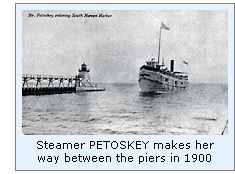 Congress
re-appropriated the necessary funds that same year, and construction
began late in 1871. Consisting of a thirty foot tall wooden structure,
the lower portion was open, supporting a single storage room topped by
an octagonal cast iron lantern. As well as offering a place to store
supplies, the small storage room served as a shelter for the keepers
when working on the light. Since waves frequently crashed over the pier
during storms, a seventy-five foot long wooden walkway was constructed
from a safe point close to shore to the tower to allow the keeper to
walk above the waves, and to provide a life-line for the length of the
pier. The walkway provided direct access to a door in the elevated
storage room. Captain W. P. Bryan was appointed as the station's first
keeper, and exhibited the light for the first time on an as yet
undetermined date in 1872. Congress
re-appropriated the necessary funds that same year, and construction
began late in 1871. Consisting of a thirty foot tall wooden structure,
the lower portion was open, supporting a single storage room topped by
an octagonal cast iron lantern. As well as offering a place to store
supplies, the small storage room served as a shelter for the keepers
when working on the light. Since waves frequently crashed over the pier
during storms, a seventy-five foot long wooden walkway was constructed
from a safe point close to shore to the tower to allow the keeper to
walk above the waves, and to provide a life-line for the length of the
pier. The walkway provided direct access to a door in the elevated
storage room. Captain W. P. Bryan was appointed as the station's first
keeper, and exhibited the light for the first time on an as yet
undetermined date in 1872.
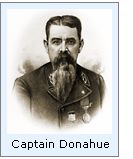 Captain James S. Donahue replaced Bryan
as keeper of the South Haven light in April of 1874. While Donahue had
lost one of his legs while serving with the Eighth Michigan Infantry at
the Battle of Wilderness, any concerns on the part of the local
citizenry that such a disability might interfere with the hardships of a
keeper's life were quickly dispelled by Donahue's dedication and hard
work. Captain James S. Donahue replaced Bryan
as keeper of the South Haven light in April of 1874. While Donahue had
lost one of his legs while serving with the Eighth Michigan Infantry at
the Battle of Wilderness, any concerns on the part of the local
citizenry that such a disability might interfere with the hardships of a
keeper's life were quickly dispelled by Donahue's dedication and hard
work.
As part of a system-wide experiment
with new illuminating apparatus, in 1890 the South Haven beacon was
selected as a trial location for a Walsbach burner gasoline light.
Evidently, the trial was successful, as it was reported that the new
apparatus doubled the intensity of the light while reducing gasoline
consumption by half.
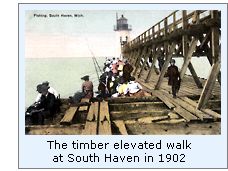 The Army Corps of Engineers continued
work on the piers and revetments at the entrance to the harbor, and at
the turn of the new century, a total of $252,000 had been expended on
the improvements. As a result, the north pier now stood at an overall
length of 1,594 feet, and the south pier at 1,554 feet, with some 470
feet of its length projecting beyond the natural shoreline. The Army Corps of Engineers continued
work on the piers and revetments at the entrance to the harbor, and at
the turn of the new century, a total of $252,000 had been expended on
the improvements. As a result, the north pier now stood at an overall
length of 1,594 feet, and the south pier at 1,554 feet, with some 470
feet of its length projecting beyond the natural shoreline.
No longer marking the seaward end of
the lengthened pier, the wooden tower was moved some 249 feet to the new
pierhead in 1901, and the elevated walk extended a like amount to bridge
the gap.
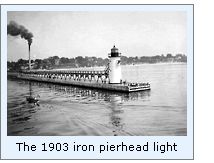 The following year, a new Fifth
Order
Fresnel lens manufactured by Parisian glass makers Barbier and Fenestre was
installed in the lantern. While the light was new, the old wooden beacon
had withstood thirty years of Lake Michigan's worst, and as a result of
increasing deterioration, Eleventh District engineer James G. Warren
laid-out plans to replace the venerable structure with a new cylindrical
metal tower. The following year, a new Fifth
Order
Fresnel lens manufactured by Parisian glass makers Barbier and Fenestre was
installed in the lantern. While the light was new, the old wooden beacon
had withstood thirty years of Lake Michigan's worst, and as a result of
increasing deterioration, Eleventh District engineer James G. Warren
laid-out plans to replace the venerable structure with a new cylindrical
metal tower.
Contracts for the metalwork and
required materials were awarded and delivered to the lighthouse depot in
St. Joseph. On October 6, 1903, the tender Hyacinth delivered the
prefabricated steel tower and a work crew on the pier, and erection of
the new structure continued through the remainder of the month. The
thirty-five foot structure was given a gleaming coat of white paint, and
the district lampist carefully removed the Fifth-order lens from the old
beacon and installed it in the new octagonal lantern. Captain Donahue
proudly climbed the spiral stairs within the new tower to exhibit the
South Haven light from atop the new tower for the first time on the
evening of November 13.
After 36 years of dedicated service,
Captain Donahue retired from lighthouse service in 1910, and was
replaced by Louis De Deimar, the former keeper of the Kenosha lights.
The final extension of the piers was
completed in 1913, and with the light tower once again stranded some
distance from the new pierhead, the tower was elevated and relocated 425
feet to the pier's new end.
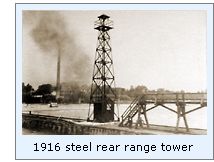 Three years later, it was determined
that range lights would serve as a valuable aid to vessels entering the
harbor, and on June 15, 1916, a fifty-two foot tall skeleton steel tower
was constructed on the pier some 800 feet to the shoreward of the
pierhead light. Displaying a fixed red light of fifty candlepower, this
new light was designed to function as a rear range, and by vertically
aligning both lights, vessels at sea could hold a course leading
directly to the channel entrance. It was quickly determined that the
light on the new rear range was not bright enough, and the intensity of
the light was increased to 750 candlepower a month later on July 5th. Three years later, it was determined
that range lights would serve as a valuable aid to vessels entering the
harbor, and on June 15, 1916, a fifty-two foot tall skeleton steel tower
was constructed on the pier some 800 feet to the shoreward of the
pierhead light. Displaying a fixed red light of fifty candlepower, this
new light was designed to function as a rear range, and by vertically
aligning both lights, vessels at sea could hold a course leading
directly to the channel entrance. It was quickly determined that the
light on the new rear range was not bright enough, and the intensity of
the light was increased to 750 candlepower a month later on July 5th.
Robert G. Young was the last Lighthouse
Service keeper to be assigned to the South Haven Light. Appointed in
1932, the same year as responsibility for the nation's aids to
navigation was turned over to the Coast Guard, Young continued to serve
until 1940, after which the keepers dwelling and light were manned by
Coast Guard personnel.
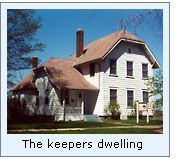 At yet undetermined points in time
thereafter, the skeletal rear range tower was removed, the wooden
elevated walkway was replaced with an iron system, and the steel tower
was given a coat of the distinctive red paint that it maintains to this
day. At yet undetermined points in time
thereafter, the skeletal rear range tower was removed, the wooden
elevated walkway was replaced with an iron system, and the steel tower
was given a coat of the distinctive red paint that it maintains to this
day.
While the Coast Guard continues to
maintain the light as an active aid to navigation to this day, the
keeper's dwelling was abandoned, and ownership the dwelling was assumed
by the General Services Administration. In 1991, the Michigan Maritime
Museum, which is located in South Haven leased the building as a
curatorial annex. When the GSA announced that the building would be
offered at public auction, a public outcry caused the GSA to reconsider,
and on a ceremony held on August 3, 2000, the property was deeded to the
city of South Haven. The Michigan Maritime Museum plans to renovate the
structure and convert it to use as a maritime reference library.

Keepers of this light

Click Here to see a complete listing of
all South Haven Light keepers compiled by Phyllis L. Tag of Great Lakes
Lighthouse Research.

Seeing this Light

Our photography field trip to South Haven in 1999 was actually our second trip,
since South Haven had been our
first stop during our seminal 1998 lighthouse tour. Unfortunately, the
only decent photograph I took the year before was taken with my digital
camera, and was captured at a measly 320 x 240 resolution, way too
coarse for any use beyond making small refrigerator magnets!
While the tower
at South Haven is quite diminutive at only 35 feet, the catwalk
appears even more dramatic as a result.
The row of lights gracefully
bending over each catwalk support beckoned for a follow-up visit after
dark, when they would look like jewels reflected in the surface of the
Lake.
We returned to South Haven on a whirlwind tour of the coast over the
last weekend in April of 2001 to photograph the keepers dwelling, and
were surprised at the amount of sand which had been blown across the
roads along the beach to the north of the river.

Finding this
Light

Take Phoenix Street
(Exit 20). Stay on Phoenix Street after
Business I-96 turns South. Continue West on Phoenix Street to the beach.
(Note that Phoenix becomes Water Street at some point along the
way!)

Contact
information

Michigan Maritime Museum
260 Dyckman Ave.
South Haven, MI. 49090
Tel: (800) 747-3810
email: mmmuseum@accn.org

Reference
Sources

Annual reports of the Lighthouse Board, 1868 - 1906
Annual Report of the Lake Carrier's Association, 1916
Around the shores of Lake Michigan, Margaret Beattie Bogue, 1985
Email from Sarah Schneider, Michigan Maritime Museum, 5/24/01.
History of the Great Lakes, J H Beers Co., 1899
Lighthouse Digest Magazine, October 1999
Personal observations at South Haven, 1998 - 2001.
Photographs by the author, 1999, 2001.
Postcard from the authors personal collection.
The Holland Sentinel, July 27, 2000
USCG Historians office, Photographic archives.
Keeper listings for this light appear courtesy of Great
Lakes Lighthouse Research
|
